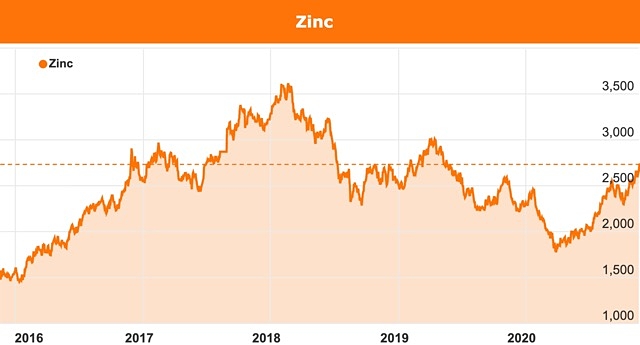Zinc price on the rise amid Gamsberg suspension and market deficit

Zinc on the London Metals Exchange hit US$2,732.50 per tonne overnight – its highest level since April 2019.
Zinc is on the move again following major global supplier Vedanta Zinc shuttering operations after a major safety incident this week at its South African mine.
The news comes as zinc on the London Metals Exchange hit US$2,732.50 per tonne overnight – its highest level since April 2019.
Earlier this week, Vedanta reported 10 of its employees had been trapped at the bottom of the south pit within its Gamsberg mine, which generates 250,000t per annum of zinc concentrate and is among the world’s 20 largest zinc operations.

Zinc prices have recovered to reach 18 month highs.
The company attributed the safety incident to a geotechnical failure.
At the time it confirmed the safety breach, Vedanta revealed eight of the 10 employees had been rescued.
Vedanta business head Laxman Shekhawat said the company was “doing everything possible” to rescue the remaining trapped workers.
The company has now suspended operations, which will remain shutdown until the country’s Department of Mineral Resources and Energy inspectors review the site in conjunction with union representatives.
Pandemic triggers fall in output
In its October 2020 update, the International Lead and Zinc Study Group estimated world mined zinc production would shrink 4.4% to 12.33 million tonnes in 2020 – largely a result of the COVID-19 pandemic causing disruptions to operations around the world.
Declining output throughout 2020 and this week’s news of suspended mining at Gamsberg has put some weight behind the zinc price in recent weeks, with the zinc market currently in deficit.
The International Lead and Zinc Study Group claims although demand has also fallen, it is still higher than output.
It predicts a deficit of 650,000t for 2020 – much higher than the 220,000t currently in stock at the LME.
The price rise comes despite LME inventory levels rising from less than 50,000t in January this year to more 219,000t by the end of October.
Chinese zinc consumption rises
A pickup in Chinese demand has been attributed to the metal’s price increase as the country’s industrial activity continues to recover post-COVID.
The country’s manufacturing PMI is currently at a two-year high and the nation accounts for about 50% of global zinc consumption.
One of the world’s largest zinc producers TSX-listed Teck Resources noted that China’s zinc mine production was down almost 4% between January and July creating lower inventory in Chinese warehouses.
However, the country’s smelter output had risen 2.4%, resulting in higher zinc consumption.
Additionally, Teck said Chinese imports of zinc concentrate rose by 39% to the end of August compared to the previous year.
Global zinc supplies to recover in 2021
Although mined zinc production is down in 2020, the International Lead and Zinc Study Group predicts it will rebound 6.6% to 13.14Mt in 2021.
With demand anticipated to reach 13.52Mt in 2021, the zinc market is anticipated to remain in deficit.
Driving next year’s expected mining recovery from the COVID shock is news Pfizer’s COVID vaccine has achieved 90% efficacy in stage three trials.
Capital Economics group chief economist Neil Shearing said the vaccine represented “a light at the end of the tunnel”.
Mr Shearing noted several other vaccines were also approaching the end of stage three trials and there was “good reason” to believe they will be as effective as Pfizer’s.
Although it will take some time for many regions to recover fully, Mr Shearing said a widespread rollout of vaccines would “clearly improve prospects” for the global economy next year.
In the mining space, it will allow companies to ramp up to full production uninterrupted.
Australian zinc miners benefit from price rebound
In Australia, New Century Resources (ASX: NCZ) is already benefitting from the improved zinc market outlook, with its share price up 36% alone in the past month.
The company operates the Century zinc-lead and silver mine in Queensland, which it claims is among the world’s top 10 zinc operations.
Former zinc miner Heron Resources (ASX: HRR) has posted a 20% increase to its share price over the last month despite its Woodlawn mine being on care and maintenance since March.
The company is evaluating its options for the project including refinancing, a possible joint venture or divestment.
LSE-listed Glencore owns most of Australia’s other large zinc mines including McArthur River in the Northern Territory and Mount Isa in Queensland.
In its latest report, Glencore claimed its Australian zinc operations had compensated for any reduced output from its other mines in COVID affected regions.
Meanwhile, Hong Kong Stock Exchange-listed MMG operates the Dugald River mine, which is also in Queensland and achieved higher output during the September quarter.
